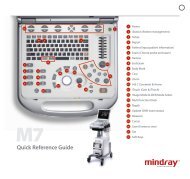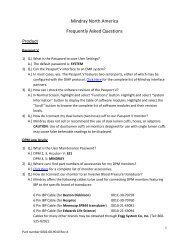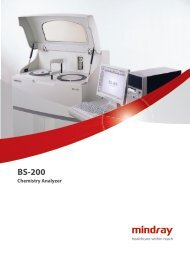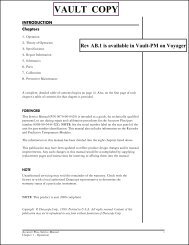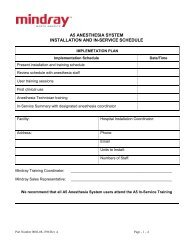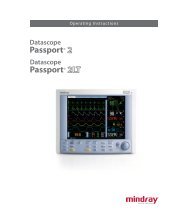Datascope Passport - Mindray
Datascope Passport - Mindray
Datascope Passport - Mindray
You also want an ePaper? Increase the reach of your titles
YUMPU automatically turns print PDFs into web optimized ePapers that Google loves.
<strong>Passport</strong> 2 NIBP Module (P/N 0670-00-0730 or 0670-00-0746-01) Theory of Operation<br />
2.15.9 Pressure Transducer, PT2<br />
The Fujikura XFPM-050KPG-BP3 transducer was selected for the over-pressure channel. Due<br />
to a transducer accuracy of ±5.625mmHg (+/-67.5mV set point tolerance at the 0mmHg)<br />
over the entire pressure range, the overpressure transducer must be zero calibrated at<br />
0mmHg in order to operate the measurement duration timer. This zero calibration is<br />
automatically performed by the software resident in the secondary Atmel microcontroller<br />
(U4). The PT2 provides a high level output signal which eliminates the need for an external<br />
amplifier circuit. All that is required is a pull-up resistor and compensation capacitor.<br />
The transducer has an output transfer characteristic of 12mV/mmHg, but due to a small gain<br />
generated by a 100kW value for R30 and a 3.60kW value for R29 in the negative<br />
feedback loop of the op-amp (U16), the transfer characteristic to be used by the software for<br />
the over-pressure channel is 12.44mV/mmHg. With 0mmHg pressure applied to the<br />
transducer input port, the output of the op-amp (U16) is approximately 100mV. Given the set<br />
point tolerance of +/-67.5mVat 0mmHg, the main processor (U10) software tracking can be<br />
off as much as 67.5mV * 3.6% or 69.93mV (5.62mmHg).<br />
The transducer is not inserted until the end of the manufacturing and cleaning processes,<br />
avoiding exposure to moisture which may effect its performance, but will be soldered in<br />
place after final assembly.<br />
2.15.10 12VSW Circuitry, Q1, Q2<br />
Disabling the pump (M1) and valves (V1 and V2) is accomplished by cutting power to these<br />
devices using a switched version of 12V2, 12VSW. This is done via the secondary<br />
microcontroller’s 12VEN* signal which controls Q1. The 12VEN* signal turns the NPN<br />
transistor Q1 on which allows current to flow through R36 and into the Q1 collector. The<br />
voltage developed on R36 turns on Q2, a P-channel FET with high current capability,<br />
supplying power to the pump and valves.<br />
2.15.11 Primary Microcontroller, U10<br />
The NIBP PCB utilizes a Motorola MC68HC16Z1CPV16 microcontroller. This specifies a 5V,<br />
16.78MHz, commercial temperature range part in a 144 pin TQFP package. This processor<br />
is responsible for controlling a pump and two valves in the generation of the patient pressure<br />
signal. This data is processed by the HC16Z1 and fed to the host via an RS-485 interface<br />
through the processor’s SCI port.<br />
A 32.768kHz crystal (Y1) is used for the HC16Z1 reference oscillator circuit. The HC16Z1<br />
SYNCR (clock synthesizer control) register will be set with X=1, W=0 and Y=60. This<br />
produces a nominal system clock frequency of 15.99MHz. The 32.768kHz crystal is<br />
specified with a load capacitance of 20pF. To present this load, C20 and C21 are set to<br />
33pF. The load capacitance is calculated as the series combination of C21 and C22 plus the<br />
stray capacitance which is estimated to be less than 5pF.<br />
At Power-On Reset, the state of the HC16Z1 pins controlling the pump and valves is such that<br />
they are disabled (pump off / valves open).<br />
2 - 50 0070-10-0441 <strong>Passport</strong> 2®/<strong>Passport</strong> 2 LT Service Manual



